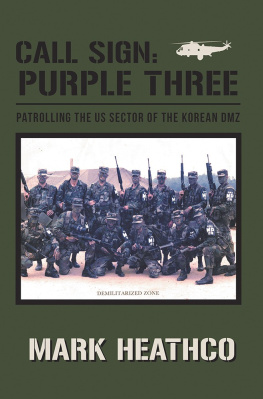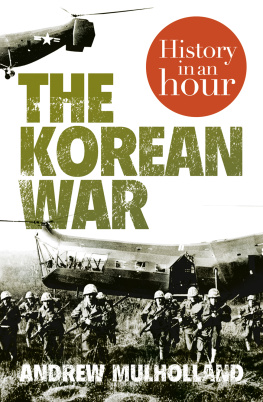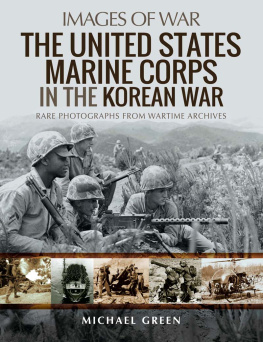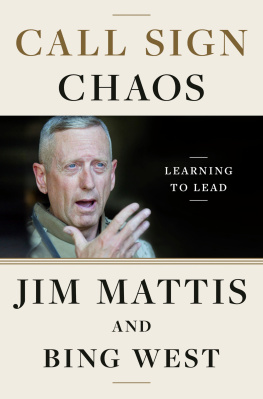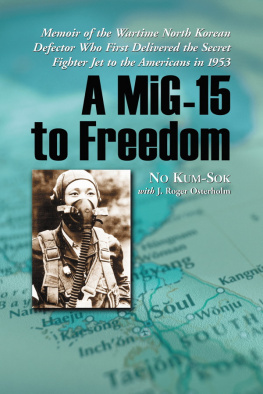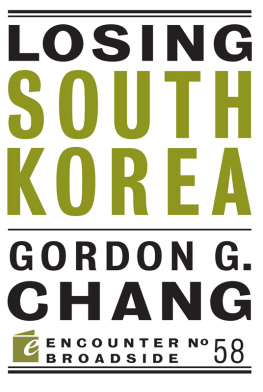CALL SIGN:
PURPLE THREE
Patrolling the US Sector
of the Korean DMZ
MARK HEATHCO
Copyright 2018 Mark Heathco.
All rights reserved. No part of this book may be reproduced, stored, or transmitted by any meanswhether auditory, graphic, mechanical, or electronicwithout written permission of the author, except in the case of brief excerpts used in critical articles and reviews. Unauthorized reproduction of any part of this work is illegal and is punishable by law.
This book is a work of non-fiction. Unless otherwise noted, the author and the publisher make no explicit guarantees as to the accuracy of the information contained in this book and in some cases, names of people and places have been altered to protect their privacy.
ISBN: 978-1-4834-8368-9 (sc)
ISBN: 978-1-4834-8367-2 (e)
Because of the dynamic nature of the Internet, any web addresses or links contained in this book may have changed since publication and may no longer be valid. The views expressed in this work are solely those of the author and do not necessarily reflect the views of the publisher, and the publisher hereby disclaims any responsibility for them.
Any people depicted in stock imagery provided by Getty Images are models, and such images are being used for illustrative purposes only.
Certain stock imagery Getty Images.
Lulu Publishing Services rev. date: 04/10/2018
This book is dedicated to the DMZ vets who patrolled inside the Z, manned Guard Post Collier and Guard Post Ouellette, and performed the mission. To all of you who chewed the same piece of dirt I did and left your footprints in the mud and rice dikes of the Korean Demilitarized Zone, welcome home from a job well done on freedoms frontier in the land of the morning calm. With little or no recognition, you pulled your duty with the utmost excellence. Stand tall and be proud of what you did on the Z, putting your life on the line to protect the freedoms of South Korea. No Second Division soldiers will ever do the DMZ mission again.
Make no mistake, my brothersyour story will be told. Like mystical warriors on the field of battle, you have fought and spilled your blood. There are none like you, nor will there be any like you again.
Keep the faith, brothers, least we be forgotten.
Mark Heathco
Preface
I was inspired to write this book for the vets who have served up on DMZ, and especially those who pulled patrol duty. Those men were the best at what they did, with little or no recognition for it. They put their lives on the line every time they went out on a mission. Most people in the United States didnt know what our soldiers were doing over in the DMZ. There were no CNN reporters embedded with them to report what was going on inside the DMZ on a daily basis. The actions these men performed were strictly covered up by the Second Infantry Division in which they served.
We were told nothing ever happened on the DMZ. Our officers and senior noncommissioned officers just laughed at the reports that the patrols brought back. We were fully loaded for combat when we went out on patrol, but our hands were tied when it came to engaging the North Koreans. It was as if the chain of command was afraid to let us pull the trigger when the trigger needed to be pulled. Now these same DMZ vets are having trouble getting benefits through the Veterans Administration and other agencies because the government says nothing ever happened on the DMZ.
I served in South Korea from 1978 to 1991 as part of the Second Infantry Division. I served with Eco Thirty-Eighth TOW Company, Camp Howze; CSC Company First Thirty-First (M) Infantry, Camp Howze; Aco First Seventeenth (M) Infantry Weapons Platoon, Camp Casey; First Thirty-Eighth CSC Company Third TOW Platoon, Camp Hovey; First of the Fifth (M) Infantry, Camp Howze; First 506th CSC Company, Camp Greaves; and the Second Infantry Division G-3, Camp Casey.
I also worked in the Third Brigade tactical operation center (TOC) from 1986 to 1990 as a shift leader. Our job was to take reports from the DMZ TOC, process them, and file them on a need-to-know basis. Some reports went to the Second Division TOC. From there, I have no idea where those reports went. But there wasnt a day that went by without some kind of incident happening inside the DMZ and involving US patrols.
Ive pulled a lot of DMZ missions and had 385 patrols inside the DMZ, on most of which I was a patrol leader. I have nine DMZ certificates and have been awarded for my action while on patrol. My personal knowledge of the US sector of the DMZ is extensive. I wrote this book on the basis of that experience, using pictures and notes I took while serving as a patrol leader. This book is about just one of the many patrols I pulled in the mid-1980s. I hope you find it as fascinating as I did.
Introduction
W elcome to the DMZ. Although a cease-fire agreement was signed in Panmunjeom on July 27, 1953, fighting between North and South Korea has never stopped. The hot war has merely been replaced by a low-intensity war. Terrorism, assassinations, infiltration of spies, and the like have replaced tank battles and artillery duels.
This book tells the real story about one of the 385 patrols I pulled inside the DMZ. The time of the patrol was fall 1985. You will join the patrol as they arrive at Warrior Base, refit for war, move to the tent area, prep their gear, receive a patrol operations order, study the patrol information, rehearse, undergo inspection, and finally execute the patrol itself. They encounter many dangers and obstacleseven a North Korean or twoas well as navigating the minefields that lace the patrol sector.
The Second Infantry Division patrolled the US sector of the DMZ until OCT 1 1991, when we turned that responsibility over to the Republic of Koreas (ROK, or South Korean) army. (Joint Security Area [JSA] personnel still patrol a sector inside the DMZ, but thats another story.) What you are about to read is the untold reality experienced by many Second Infantry Division soldiers. Folks in the United States have never heard about these patrols. Events were hushed up to make it look like nothing ever happened in the DMZ. All the reports were localized to battalion, brigade, or division intelligence offices. Today in 2013, there is no paper trail that I know of showing that we ever patrolled the DMZ.
I wrote this book hoping to give the people in the United States a better understanding of what these soldiers did and the sacrifices they made. These men suffer today from many forms of combat problems. Though the DMZ was not considered a hot environment of battle, the soldiers who served there still suffer. I hope my book sheds some light on their dark road.
Mark Heathco
Day One
Chapter 1
THE ARRIVAL
I t all starts August 29, 1985, at about 0430 hours. This is what we have been training the last three months for; all the problems weve solved and mock patrols weve done in the field are now going to be put to use. Our mission is to patrol the US sector of the Korean Demilitarized Zone and to deter any aggression or infiltration that may occur, to the extent of engaging the North Koreans with deadly force. I think, Were finally here on the DMZ.
The convoy of jeeps passes under a tank trap, weaving its way through the yellow-and-black-striped metal road barriers blocking the road north to Freedom Bridge. Were on the main attack route used during the war by the North Koreans, now known as Main Supply Route One, or MSR1 for short. The road leads straight to the capital city of Seoul if you take it south. It becomes a four-lane highway right after you cross Freedom Bridge: two lanes south and two lanes going north to the Imjingak. Go any farther north and it narrows to two lanes. Once you cross Freedom Bridge going north, the highway leads to a check point at the joint security area (JSA) Camp Kittyhawk. Then to a tank trap, tank wall and a mine field, the southern barrier fence, the US sector of the demilitarized zone (DMZ), and on to the Bridge of No Return at Panmunjeom. They say if you keep following it north, you will drive right into Kaesong, North Korea.
Next page
